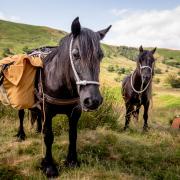Edward Acland takes us on a tour of a 170-year-old mill which has become a temple to the art of recycling.

SMASHED glass from a vandalised bus shelter would seem to be the ultimate in rubbish destined for landfill.
But to Edward Acland it is another opportunity to make a piece of art. It joined old disused keys, nails, knitting needles and stones to make the landscape: Key and Nail Rivers.
For this sprightly 74-year-old has been on a life-long mission to banish the whole concept of waste from the English dictionary, to be replaced by resource.
His base, shared with his retired doctor wife, Romola, is Sprint Mill, two miles North of Kendal, off the A6.

The three-storey building, encompassing five open spaces, was built in 1840 on the site of a previous mill destroyed by fire.
It was originally a fulling mill processing the wool from the farms on the fells roundabout.
Under the Aclands’ careful custodianship, Sprint Mill has become an artwork in its own right.
It houses a lifetime’s collection of artefacts, akin to entering an installation that immerses the visitor in the dusty history and meaning of objects.

The light emphasises and contrasts the natural textures and colours of the building and its salvaged contents. The soundtrack is the cascading waters of the fast-flowing Sprint, a tributary of the Kent.
‘I bought the Mill in 1964 against everybody’s advice. People worried about its terrible physical state,’ says Edward, who at the time worked for the National Trust in Ambleside as an assistant agent. ‘But I had fallen in love with the building and decided that is where I wanted to be and to sort it out.’
The couple, who live in the former workers’ housing next door, made slow progress for decades, quietly and methodically converting the mill into workshops, studios and creative installations.
He mounts his own exhibitions with jars full of obscure raw materials and “pictures” made of debris dropped between double-glazing, with the layers building up into an image. Materials can be anything from mouse nests and goat poo to barbed wire and ground coffee.
He also collects tools and other engineering or building materials. ‘I have the greatest of respect for the lovely things that crafts people have made over the years, especially from the peasant culture,’ he says.
A grant through Natural England’s Higher Level Stewardship scheme in 2012 meant a major restoration of Sprint Mill could take place, with new roof and walls completely rebuilt.
‘Now the mill will be in a good state for another 100 years, long after I have gone,’ says Edward wistfully. He is not looking forward to the boredom of death, enjoying living so much. In the meantime his creativity knows no bounds.
On the day Lancashire Life visited the mill, he had been for a weekend visit to St Bees on the Cumbrian coast and was horrified by the amount of plastic on the beach.
He gathered it up and was arranging it into another potential work of art. No doubt it will enforce his philosophy.
‘I have a strong belief that humankind can be a benefit to planet earth and I like to think the way we live here contributes rather than takes away.
‘I was a member of the district and county council for 23 years, but when that came to an end I decided I wanted to use my home space to display my concerns about the impact humans have on planet earth.’
Beyond art, that philosophy extends into all areas of life. The couple grow their own fruit and vegetables, cooking them to store in reusable jars, instead of using a freezer. Heating and cooking is fuelled by wood from sustainable trees grown entirely on the 15-acre estate.
The ash and willow branches are nibbled by the resident herd of goats, so the stripped wood dries quicker for burning. The male kids end up in the cooking pot. ‘Our aim is a perma-culture where we move towards living quietly and gently on planet Earth rather than just consuming.’
He would love to see the Mill wheel turning again, and has partly restored the turbines that were once used to power it. The cost is prohibitive, but any local energy companies interested would get a sympathetic hearing.
The lifestyle obviously rubbed off on the Aclands’ three children. Youngest, William, is a master craftsman who runs a furniture making and training company in nearby Staveley. Middle child Florence is an artist, photographer and gardener. She also photographs Edward’s creations for framing. Eldest, Thomas, is a computer engineer, but his spare time is taken up sailing and restoring dinghies with a passion to make sure they keep going and look loved. ‘They have all found their own niche,’ says an obviously proud Edward.
As well as banishing words like waste, Edward would like to add his own invention: Cagmagery. The definition, when, not if, it gets into the dictionary, will be ‘that mixture of bits and pieces you can’t bring yourself to throw away.’
To illustrate, he points to a picture made of broken Christmas baubles. ‘Even if something gets broken it can be turned into something attractive,’ he says.
The mill is on a footpath crossroads and is on an alternative route for the Dales Way, so is often busy with casual visitors.
It also acts as a magnet for like-minded artists, some of whom put on exhibitions there.
Edward welcomes groups of artists, photographers, gardeners or others who want to have a tour. E-mail: mail@sprintmill.uk or telephone 01539-725168.



























